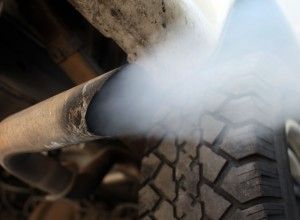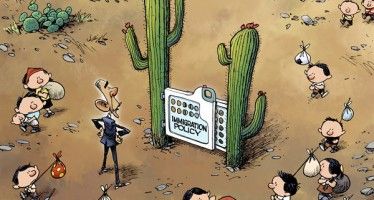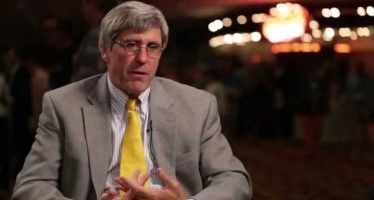CA regulators plot end to gas-fueled cars
California officials have begun a massive effort to eventually eliminate gas-fueled cars from state roads, led by a powerful regulator with Gov. Jerry Brown’s unwavering support.
Legislating the future
Mary Nichols, head of the state’s Air Resources Board for the past eight years, “is pushing regulations today that could by midcentury all but banish the internal combustion engine from California’s famous highways,” as a recent Bloomberg interview revealed.
More than any other single official, her sway has been potent and protracted. In addition to overseeing state emissions policy, “Nichols plays a central role in deciding where Californians get their energy, what fuel goes in their cars and how their homes are built,” the Los Angeles Times observed late last year in a report on her “rock star” influence.
 On emissions, Nichols’ labors have led up to a key legislative session next month. “September will be the biggest test for the 70-year-old Nichols’ grand plans,” according to Business Insider. “That’s when her mandate of having only zero-emissions on California roads by 2050 will be debated and voted upon by the state Legislature.”
On emissions, Nichols’ labors have led up to a key legislative session next month. “September will be the biggest test for the 70-year-old Nichols’ grand plans,” according to Business Insider. “That’s when her mandate of having only zero-emissions on California roads by 2050 will be debated and voted upon by the state Legislature.”
Tough to tougher
A victory for Nichols in Sacramento would dramatically exceed the Golden State’s already substantial auto regulations. “The zero-emissions vehicle program that California has in place at present requires that 2.7 percent of new cars that are purchased within the state in 2015 be free of greenhouse gas emissions,” as Gas2.org noted. “Under current plans, California will gradually increase this figure starting in 2018, so that, by 2025, as many as 22 percent of all new cars sold in the state are required to be emissions free.”
In pushing past those strictures, Nichols has become the chief enforcer of Gov. Brown’s broad environmental vision. Although then-Gov. Arnold Schwarzenegger began her current tenure, it marked a return to the regulatory role Brown had carved out for her turning his first two terms in office. Between stints, “Nichols’ career resembled a grand tour of California’s environmental world,” according to the Times: “Opening the Natural Resources Defense Council’s Los Angeles office, leading the Environment Now foundation, serving as resources secretary for Gov. Gray Davis. In a detour to Washington, she worked in the Environmental Protection Agency under President Clinton.”
It was not difficult for Nichols to pick up where she left off when Brown regained the governorship. In 2013, she made Time’s list of the world’s most influential people. “There’s no daylight between what I think and what Mary thinks on climate change,” Brown told Bloomberg. In April of this year, he issued an executive order mandating, by 2030, a reduction in statewide emissions to a level 40 percent lower than attained in 1990.
More rigorous than the policy of any government in North America, Brown’s framework drew international attention. Largely convinced that even sweeping action at the national or regional level lacks the reach to significantly alter global environmental conditions, climate change activists and sympathetic policymakers have increasingly looked upon Brown’s efforts as a catalyst that could inspire similarly aggressive measures around the world. “There can be no substitute for aggressive national targets to reduce harmful greenhouse emissions,” World Bank president Jim Yong Kim remarked at the time, “but the decision today by Governor Brown to set a 40 percent reduction target for 2030 is an example of climate leadership that others must follow.”
Upcoming negotiations
Beyond what happens in Sacramento this September, auto makers have hunkered down for another round of jockeying with Nichols over next year’s review of zero-emissions vehicle rules — a suite of mandates incorporating credits and incentives “more complicated than a simple numerical quota for electric vehicles,” according to Bloomberg. Automakers, doubtful that demand for all-electric vehicles will match Nichols’ goals, have already pushed for an increase in credits for hybrid vehicles.
Convinced that California’s emissions targets won’t be met until they comply, Nichols told Bloomberg “she can offer expanded preferential access to freeways and parking spaces for ZEVs, along with more charging stations and bonuses for dealers. She mentions another possible concession: a slower acceleration of the ZEV mandate.” Although car companies like Tesla have reason to cheer such developments, for others, Nichols’ persistence augurs another long summer.
Related Articles
CA legislation, lawsuits shake up immigration law
A series of political and policy moves have dramatically unsettled immigration law in California, both at the state and federal level.
VIDEO: Can the GOP build a better brand by embracing unions?
We may be experiencing a libertarian moment, but are blue collar workers the secret to give this moment a lasting
SeaWorld to drop San Diego orca shows
Scrambling to salvage its business amid a wave of negative publicity, SeaWorld has scrapped its traditional orca shows, banking on shaky





